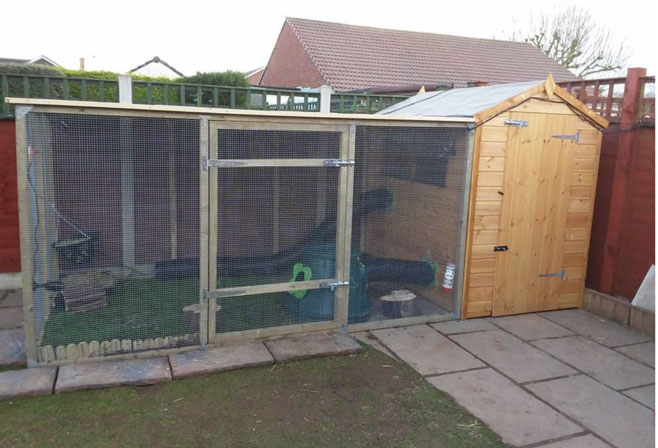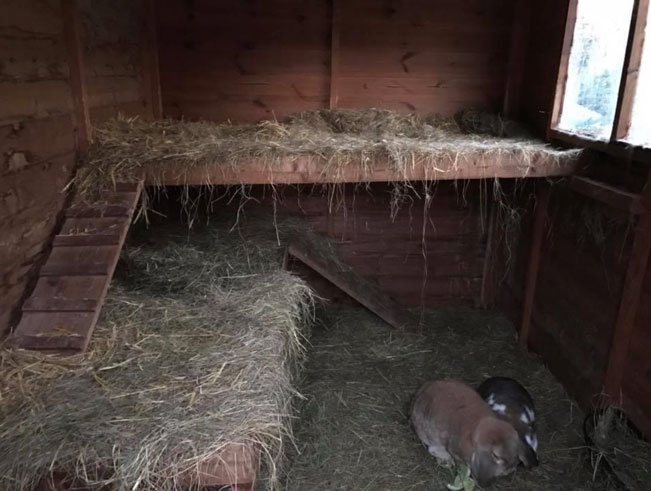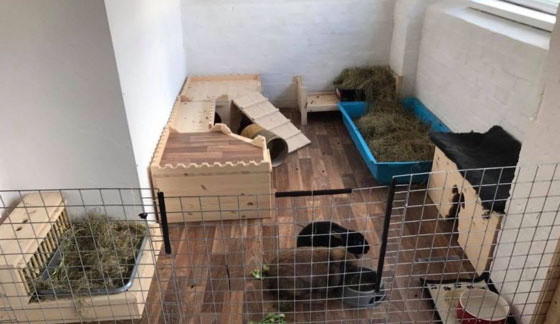Pet rabbit welfare guidance
This document provides detailed information about the needs of pet rabbits and how to meet these needs in accordance with good practice.
Section 3: The need for a suitable environment

Pet rabbits should have access to appropriate places and opportunities to do all of the following:
- rest and sleep in comfort
- eat and drink undisturbed
- toilet in an appropriate place
- exercise freely and explore safely
- hide when afraid or feeling insecure
- shelter from the weather including wind, cold, draughts, rain and sun
- keep warm in nesting materials
- interact with (and escape from) companions
- play, including chewing and gnawing if they want to
- mark their scent on solid objects
- look out for companions or danger
- dig and forage
This section offers guidance on providing your rabbits with a suitable living shelter and exercise area to meet these needs. The space you need depends on the size of your rabbits – and the size they will become. The minimum total area required for 2 average-sized rabbits is 10ft (3m) x 6ft (180cm) x 3ft (90cm) high.
Living shelter
Your rabbits' shelter should have at least two compartments: a darkened sheltered area for sleeping and another for eating / relaxing. House rabbits should be provided with a secure area where they can feel safe, sleep, toilet and be kept in when unsupervised.
The shelter should be large enough to allow all your rabbits to perform their natural behaviours simultaneously, in order to avoid competition for, and monopolisation of, resources. As a minimum, the shelter should:
- be large enough to allow all your rabbits to lie down and stretch out comfortably in all directions, at the same time,
- be high enough for them to stand up on their back legs without their ears touching the top, and
- be long enough so that they can move around, feed and drink. As a guide, all your rabbits should be able to take a minimum of three big hops from one end to another, at the same time.
The minimum recommended size for a suitable shelter for 2 small or medium breed rabbits is 6ft x 2ft x 2ft (180cm x 60cm x 60cm). The size you need will depend on the size of your rabbits. For example, a giant rabbit's hop can be 4.5ft in length, so accommodation for rabbits of this size will have to be much bigger, and medium-sized rabbits are likely to need a height of at least 75cm to allow them to stand up fully without their ears touching the top.
If your rabbits live outside, their shelter should be sturdy, easy to clean, waterproof, raised off the floor, and positioned out of the prevailing weather, sun and draughts. A shed or playhouse fitted with a cat flap or other device which allows access to a secure run is ideal accommodation. A large hutch with access to a run is a good alternative, although it should be noted that many of the hutches currently on the market provide considerably less space than is recommended for 2 rabbits. If a hutch is used, it should be weatherproof, but can also be brought into a shed, building or outhouse for the winter months to provide protection from bad weather.
Substrate and Bedding
Your rabbits' shelter should be lined with appropriate material (substrate) to catch urine, faeces, food and water spills, etc. This substrate layer helps keep the shelter hygienic, but it should also be comfortable underfoot. Suitable materials include dust-free, non-toxic wood shavings or shredded paper. Sawdust is not suitable as it can be very dusty and may cause respiratory problems.
Your rabbits will spend a significant amount of time on this substrate, so choosing the right product can greatly improve their comfort and quality of life.
Bedding, such as dust-free bedding hay or soft straw, should be also provided to give your rabbits extra insulation, somewhere to hide, and added comfort. It should be clean and dry and should also be safe for your rabbits to eat if they choose to (although their main food should be higher quality feeding hay).

Exercise Area – the run
Rabbits are very active animals and need to be able to exercise appropriately, i.e. hop, run and play. Jumping on and off raised areas, such as platforms or hay bales, helps rabbits maintain their bone and muscle strength. If your rabbits do not have enough exercise, their bones can become weak and break, they can develop muscle wastage and can become obese. Lack of exercise can also have a detrimental impact on your rabbits' mental health.
Your rabbits should have access to a safe, enclosed exercise area where they can run and jump. Ideally, this should be attached to the living shelter, so that your rabbits have constant access to it. However, if this is not possible, they should have access to their exercise area every day. If their living area is moved indoors in winter, it is important that the exercise area is still available at least daily.
The run should be large enough to allow your rabbits to stretch upwards to full height without their ears touching the roof, and to run, as opposed to just hop at least 3 times. The minimum recommended size for a run for 2 rabbits is 8ft x 6ft and 3ft high (240cm x 180cm by 90cm high), but again the size of your rabbits should be considered and a larger run provided for bigger rabbits.
The run should contain raised areas for jumping on to and preferably should be outside with access to a grassy area. It should be escape-proof to the extent that your rabbits cannot burrow under the sides of their run. It should also be secure enough to prevent access by rats, or predators such as dogs, cats, foxes and birds of prey. There must be sufficient shelter for all the rabbits to be protected from the sun, wind and rain.
Indoors and outdoors: hiding places
Rabbits should be given hiding places where they can run to if they feel afraid, stressed, unwell, or simply want to be on their own for a while. Suitable hiding places include cardboard or wooden boxes, sections of wide-bore drain pipes and shelves that your rabbits can get under.
It is useful if there are a range of options for hiding places, but there should always be at least the same number of hiding places, of an appropriate size, as there are rabbits. If you have different sized rabbits, it is good idea to provide a hiding place that only the smaller rabbit can enter. Likewise, it is vital to make sure that there are two access points in each hiding place, to prevent one rabbit trapping another in there, or barring their entry. It is also a good idea to provide one hiding place large enough for all the rabbits to use together, if they want to.
To ensure rabbits feel safe in their hiding place, it is important that they are never trapped in them or removed from them.
Ventilation and temperature
It is important to protect your rabbits from bad weather, draughts, extremes of temperature and direct sunlight. In addition to the advice given below, particular care may need to be taken if your rabbit is sick or elderly, as they may have trouble controlling their body temperature. Your vet will be able to advise you about this.
When housed outdoors, extra bedding material should be provided for added warmth on cold nights, and a cover, blanket or piece of old carpet could offer added insulation to the shelter. However, poor ventilation is a common cause of respiratory disease. If a hutch cover or blanket is used then it is essential that ventilation is maintained by an air inlet at a level above the rabbits' ears and air outlet just under the eaves of the hutch roof in both compartments. Specialist pet heat discs can also provide a good source of heat in very cold weather but make sure they are securely covered in a material that is thick enough to prevent your rabbits coming into direct contact and suffering from any burns. Specialist heat lamps can also be fixed to the outside of the shelter in very cold conditions, but extreme care must be taken when using heat sources in close proximity to hay and straw. Hot water bottles are not a good idea, as rabbits can chew through them and get burnt.
It is also important to ensure that your rabbits do not get over-heated. Sheds can become very hot if they are in direct sunlight, even in winter, so it is important to consider this when deciding where to put your rabbits' shelter. The position of the shelter and exercise area should take into account the movement of the sun and ensure that there is no time at which rabbits are left without the ability to escape the heat of the sun.
When housed indoors, the rabbits' living area should be placed in a cool room, away from radiators, out of direct sunlight and draughts.
If your rabbits' environment becomes very warm and it is not possible to move them into a cooler place, cool pads or frozen water bottles can be used to prevent overheating, or you can put ceramic tiles on the base of the shelter as a cool surface for your rabbits to lie on. If they do become overheated, you can dampen down your rabbits' ears with a cold wet flannel.
Sudden changes in temperature are not good for rabbits. It is therefore not a good idea for your house rabbits to go out into an uninsulated outdoor run on the coldest winter days, having spent the night in a centrally-heated house. Likewise, it is not a good idea to bring your outdoor rabbits in to a centrally-heated house on cold winter nights, and put them back outside during the day. If you get your rabbits in winter, and they have previously been kept in a warm, indoor environment, it is important not to put them into an outdoor living area unless you are sure that it is properly insulated and that you have provided heat sources.
Hygiene
The rabbits' environment must be kept safe, clean and hygienic. A toilet area should be provided, filled with shredded paper, or dust-free, non-toxic, wood shavings or hay. Alternatively, you can put some of these materials, or other non-clumping, not-toxic and non-expanding paper-based litter, into a litter tray. Rabbits tend to choose one area to use as a toilet, which makes them fairly easy to litter train.
Every day you should remove and replace any wet or dirty litter or bedding, clean toilet areas, remove any uneaten fresh foods and thoroughly clean water and food containers. The entire shelter should be cleaned and disinfected at least once a week, renewing all bedding and shavings. It is important that a non-toxic, rabbit-friendly disinfectant is used, and that the accommodation is completely dry before the rabbits are returned to it. As cleaning can be stressful for rabbits, it is recommended that after cleaning, a small amount of used, but unsoiled, bedding and nesting materials be returned to the shelter. This will smell familiar to the rabbits and can help reduce the stress that has been caused by the cleaning process.
Exercise areas should be regularly cleaned. The run can also be moved onto a new area, but each area should be cleaned after use.
Protection from hazards
Your rabbits' environment should be safe, secure and free from hazards. Their shelter and exercise area should be checked regularly for damage, and repaired or replaced when necessary. All areas to which your rabbits have access should be 'rabbit-proofed', and it is important to contact your vet promptly if you think your rabbits have come into contact with anything which could harm them.
If your rabbits have access to your garden, it is important that they are kept away from any areas where you have been using herbicides, pesticides, or other poisons such as slug pellets. Likewise, you should not allow your rabbits access to flower beds or other areas that are likely to contain poisonous plants. Further information about plants which might be poisonous to your rabbits can be found on the RWAF website:
https://rabbitwelfare.co.uk/rabbit-care-advice/rabbit-diet/poisonous-plants-rabbits/
Indoors, you should ensure that any houseplants which might be poisonous to rabbits are kept out of reach, and that their petals are not able to drop into an area to which your rabbits have access. Wires and cables should be covered or kept out of reach, and you should ensure that your rabbit has no access to any potentially dangerous areas ( e.g. oven).
Travel
If you need to transport your rabbits anywhere, they should travel in a secure pet carrier of adequate size with good ventilation. The carrier should be secured firmly in place with a seat belt, or wedged in the footwell of the car, making sure there is adequate ventilation. You should also ensure that the carrier is not placed where your rabbits will become too hot, such as in direct sunlight or next to the car's heating vents. Do not put the carrier in the enclosed boot of a car. The pet carrier should be cleaned after each use, and disinfected if necessary, especially if it is used for more than one pet.
Rabbits which live together should be transported together in order to maintain their bond, and to avoid any problems associated with reintroduction.
Rabbits need to eat continuously due to the way their digestive system works, so it is recommended that rabbits are provided with enough hay in their carrier to last the journey and should have constant access to fresh, clean water. Water should be provided in a way the rabbits are used to (eg bottle or bowl), and the water supply should be checked regularly. It is also important to ensure that the rabbits are continuing to eat normally after a journey.
Rabbits should never be left unattended in a car or other vehicle. The temperature in a parked vehicle can become very high extremely quickly and cause heat stroke or even death.
When you are away
You have a responsibility to make sure that your rabbits are cared for while you are away. As many rabbits prefer to stay in a familiar environment, you may wish to make suitable arrangements with a neighbour or pet sitter, but you should make sure that they can meet all of your rabbits' needs and any special requirements they may have.
Alternatively, you may wish to consider whether a good boarding facility would be better, where your rabbits can be monitored and cared for by someone knowledgeable on how to look after rabbits. It is important that you ensure you are aware of, and comply with, any health or disease control requirements stipulated by the boarding facility.

Contact
There is a problem
Thanks for your feedback